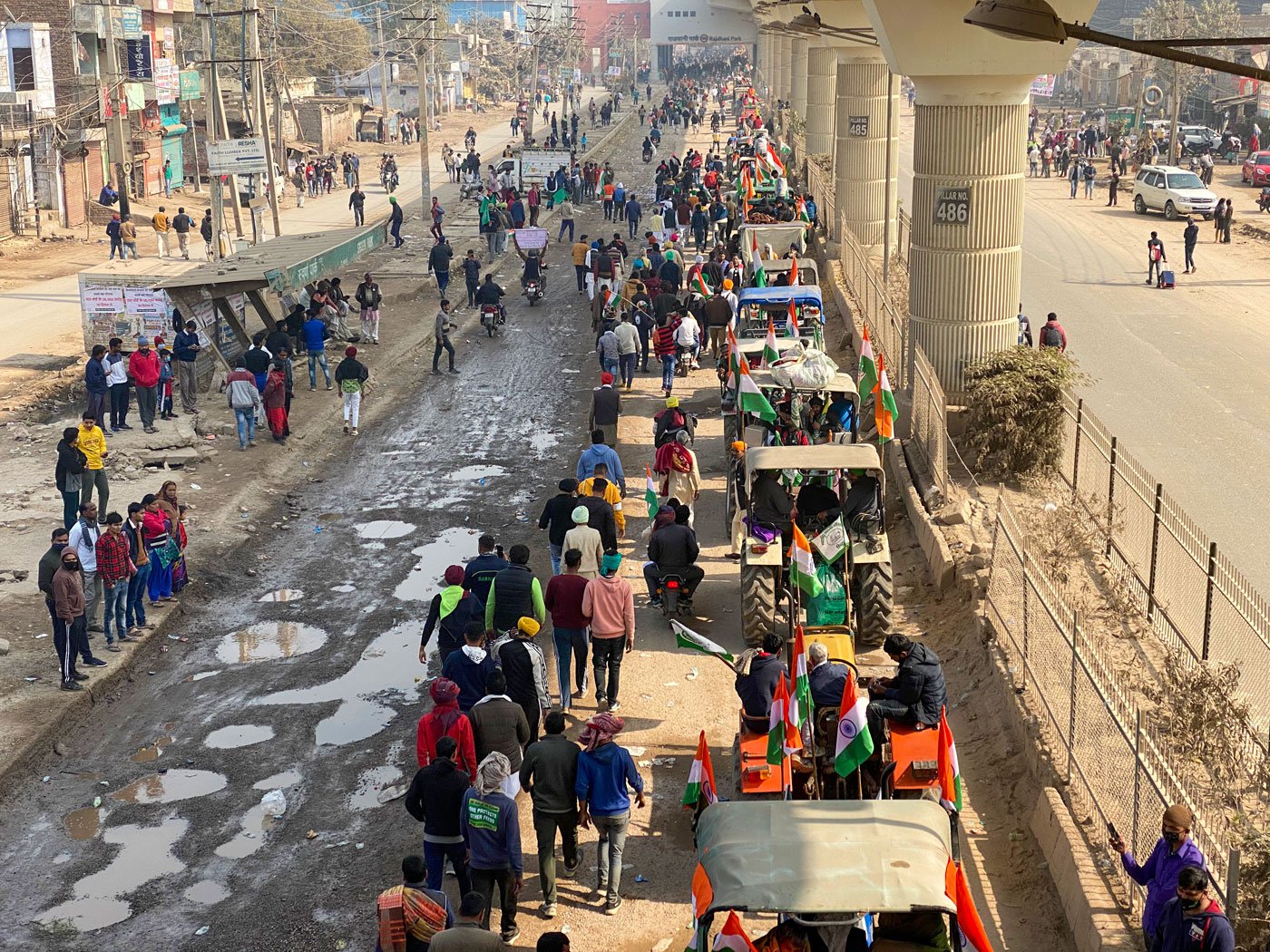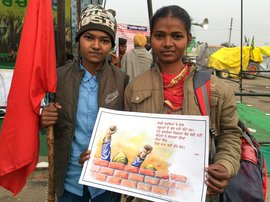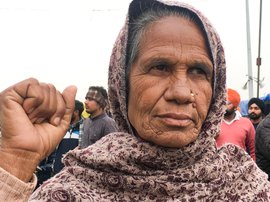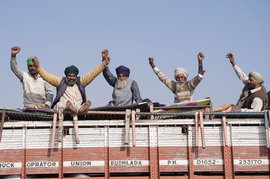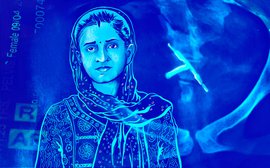“All 32 unions request the naujawan [youth] to cause no harm. No one will cause any damage. No one will clash. No one will spoil this struggle of ours,” rang out an appeal. “All will follow the official route allotted to us by the Delhi Police. We will march peacefully for the world to see,” the leader said over a loudspeaker placed on a tractor.
It was around 9:45 a.m. on January 26, and the convoy of tractors was moving past the Mundka Industrial Area metro station when the loudspeaker crackled to life. Volunteers had rushed forward to make a human chain, asking everyone to stop and listen to the leaders’ appeal.
The rally had started off at 9 a.m. from Tikri in West Delhi, amid chants of ‘Kisan Mazdoor Ekta Zindabad’. Besides the convoy, many protestors and volunteers marched on foot – some holding the national flag, others carrying their farm union flags. “We request those on foot to get onto the tractors as we have to cover a long distance,” the leader speaking on the loudspeaker said. But many of those walking continued on foot.
As the convoy moved smoothly ahead, more and more residents from the Mundka neighbourhood stopped by to watch, standing by the sides of roads or on dividers. Many recoded the unprecedented parade on their phones, some waved, others danced to the dhols being played.
Among the Mundka residents was 32-year-old Vijay Rana. He had come to shower marigold petals on the farmers as they moved past his locality. “When politicians can be greeted with flowers, then why not farmers?” he asked. Rana, a farmer himself, cultivates wheat, paddy and bottle gourd on 10 acres in Mundka village. “Farmers are no less than soldiers,” he added. “If the soldiers of this country leave the borders, then anyone can take over this nation. Similarly, without farmers, the country will starve.”
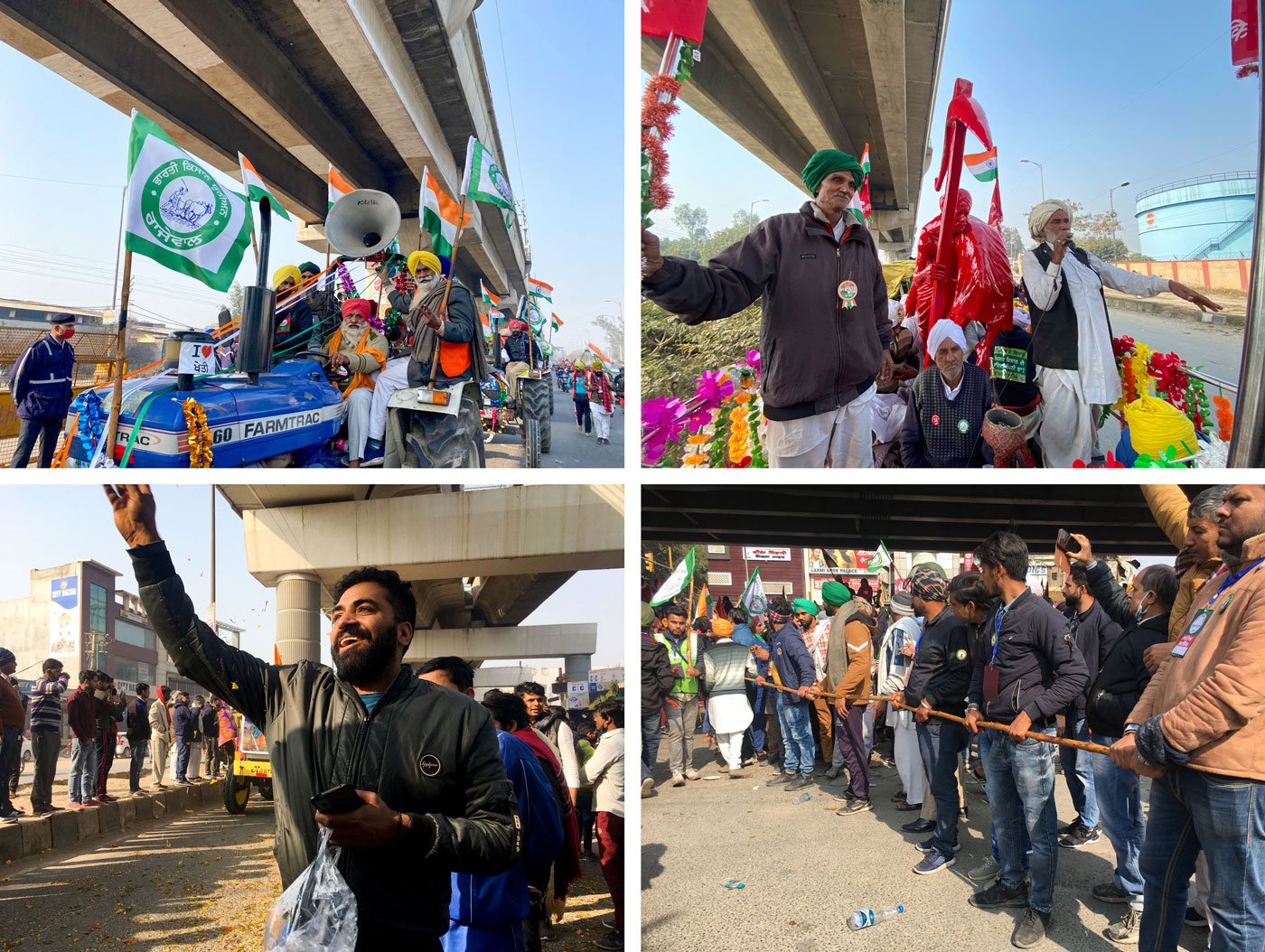
On the road from Tikri (top row): Around noon, confusion took over at Nangloi chowk (Photos: Satyraj Singh). Bottom left: Vijay Rana, a farmer from Mundka, greeting the parade with petals. Bottom right: Volunteers formed a chain at at Nangloi chowk guiding farmers to move towards Najafgarh (Photos: Sanskriti Talwar)
This massive tractor rally – on the occasion of India’s 72nd Republic Day – was called by a coalition of 32 unions and organisations from three major border points of Delhi – Tikri (in the west), Singhu (north-west) and Ghazipur (in the east) – all sites where tens of thousands of farmers have been stationed in protest against the three farm laws since November 26, 2020.
Around 7,000 tractors were likely to start from Tikri, the police said at a press conference before Republic Day. Shinghara Singh Mann, press coordinator of Bhartiya Kisan Union (Ekta Ugrahan) told me that from his union at least 6,000 tractors took part in the parade from Tikri. While Sukhdarshan Singh Natt, state committee member of the Punjab Kisan Union told me they can't give an estimate of the number of tractors that participated. Their main aim, he said, was to carry the rally peacefully. He added at around 8:45 a.m., all tractors from their union were lined up at Tikri. And by the time the last few tractors returned, it was 6 p.m. So nobody could keep count.
The circular route chalked out by the Delhi Police for those protesting at Tikri was through Nangloi, Najafgarh, Jharoda Kalan, KMP Expressway (on the western periphery of Delhi), and then back to Tikri – a total of 64 kilometres. Initially, three routes were mapped out by the Delhi Police for convoys starting from Tikri, Singhu and Ghazipur. However, Shinghara Singh Mann said informally, nine routes were discussed and decided between the police and the union leaders.
But around noon, complete confusion took over at Nangloi chowk , just below the flyover. Instead of turning right to go to the next point on the designated route, Najafgarh, some individuals and small groups of farmers insisted on continuing straight towards Peeragarhi chowk to try and reach central Delhi from there. The volunteers and coordinators continued to guide the rally to take a right turn towards Najafgarh.
Around 20 minutes later, a group of farmers in tractors broke the barricades at Nangloi chowk , amidst hooting and shouting from the occupants of some of these tractors. Locals watched the chaos from their terraces, many came out to the road to watch. The police kept announcing that they are monitoring the miscreants. The cops also deployed a drone to record the situation.
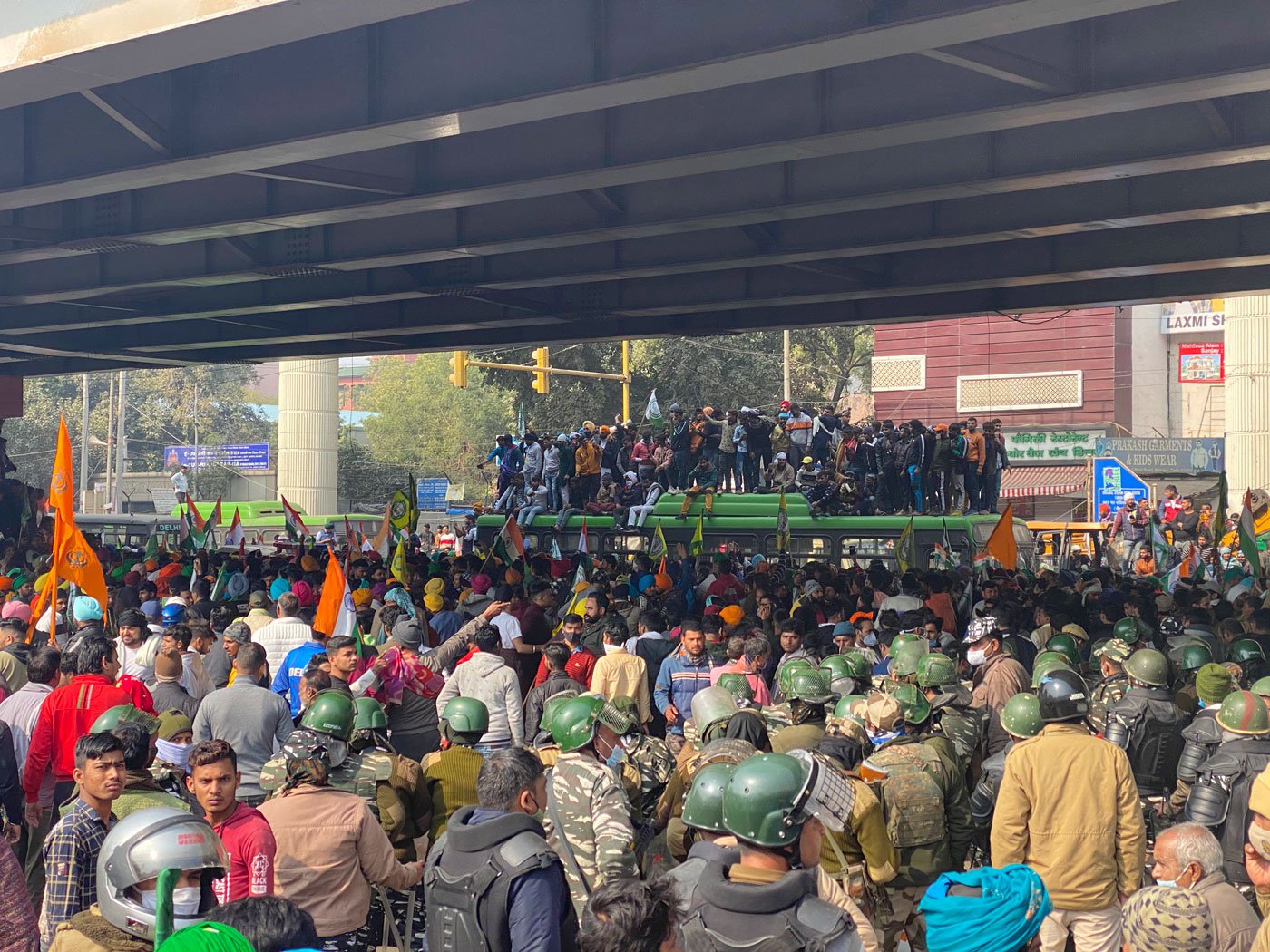
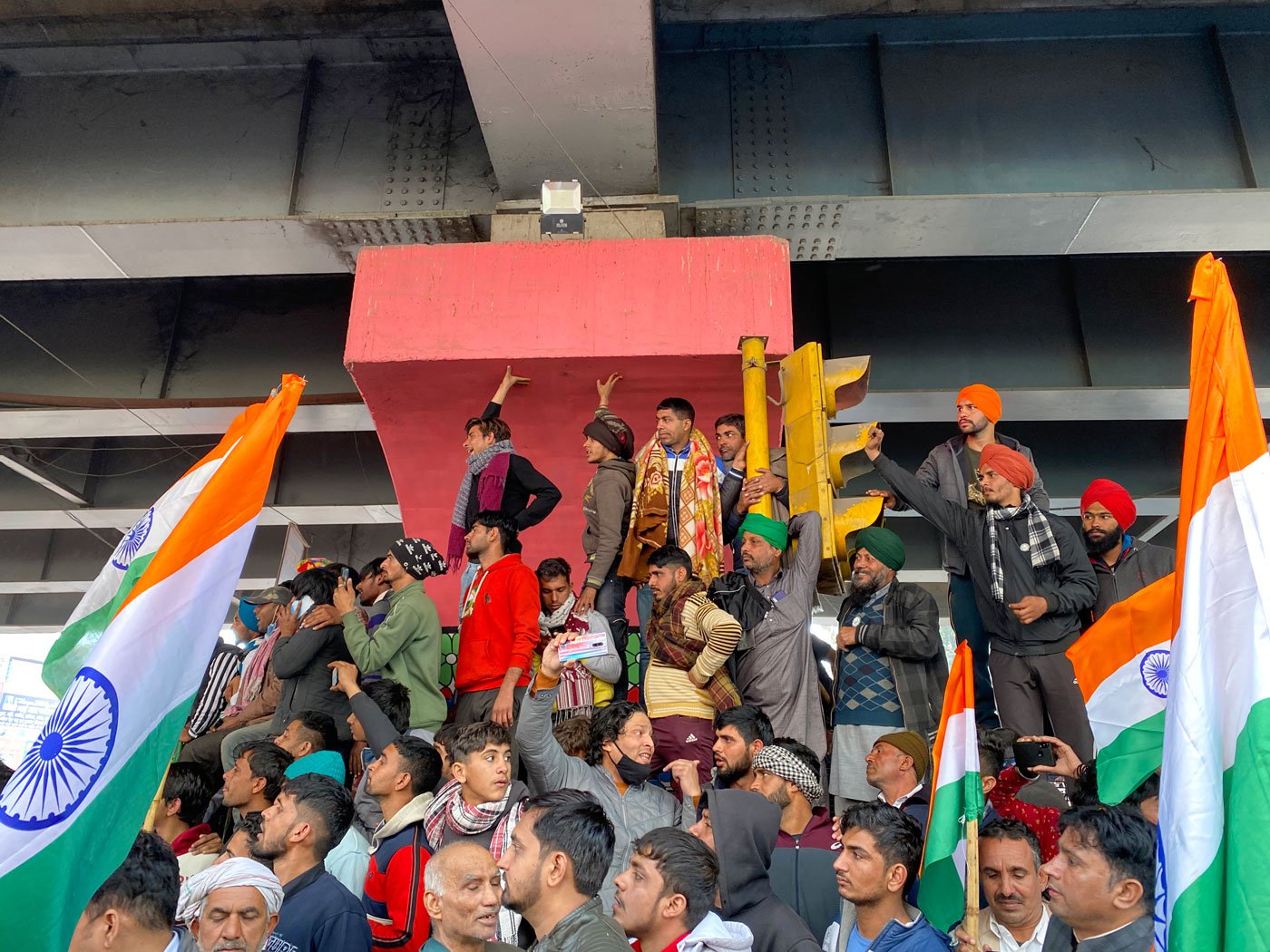
Still peacefully proceeding at Nangloi (Photos: Satyraj Singh)
Amidst the chaos, Gurdiyal Singh from Delhi, a volunteer, went to a stage built in a corner of Nangloi chowk , and again requested everyone to move right on the road to Najafgarh. “If we want our demands to be heard, we must go in the right direction [ follow the route designated by the Delhi Police] I request all to carry this march with peace and love,” he said.
“Lakhs of people had joined in the rally. Many had joined from the neighbouring areas too. We were constantly requesting all to follow the designated route and maintain discipline. But it was difficult to keep an eye on everyone,” Jasbir Kaur Natt, state committee member of the Punjab Kisan Union, among those camped at Tikri, later told me.
Despite the disruption at noon at Nangloi chowk , a peaceful march went ahead on the original route. The convoy included tractors of farmers affiliated to the Punjab Kisan Union, All India Kisan Sabha, and the Bharatiya Kisan Union, among other unions. Another contingent from the Bharatiya Kisan Union (Ekta Ugrahan) joined in at Najafgarh road from the opposite direction. They had taken the KMP Expressway (the designated route is circular – from Tikri one could either take the Nangloi arm or the KMP arm and reach the same points).
Among the many passing through the Nangloi-Najafgarh road on a tractor was Poonam Pattar, 35, from Surewala village of Haryana’s Hisar district. She came to Tikri on January 18 with her family. Since then, they have been staying in their trolley parked at Bahadurgarh (near the Tikri border). Poonam is a homemaker who said she learnt to drive a tractor only to be able to participate in this parade.
“At Rajpath, every year on Republic Day, dramas are enacted about farmers working in their fields. But this is the reality. Through this rally farmers are truly showing that they are the providers of food to this country,” she said. “I will stay here for as long as the protest goes on. If everyone else joins in too, it will the right and praiseworthy thing to do.”
Most of the other tractors were driven by men, while groups of women sat in the trolleys. “We want to show that we are not terrorists. We want to show the Modi government that no one can shake our unity,” said Jasvinder Kaur from Mehlan village of Punjab’s Sangrur district, who was in one of the trolleys. “We have come here to protest against these black farm laws. We will not return until these laws are repealed. We will carry on with our protest peacefully and will do no harm.”
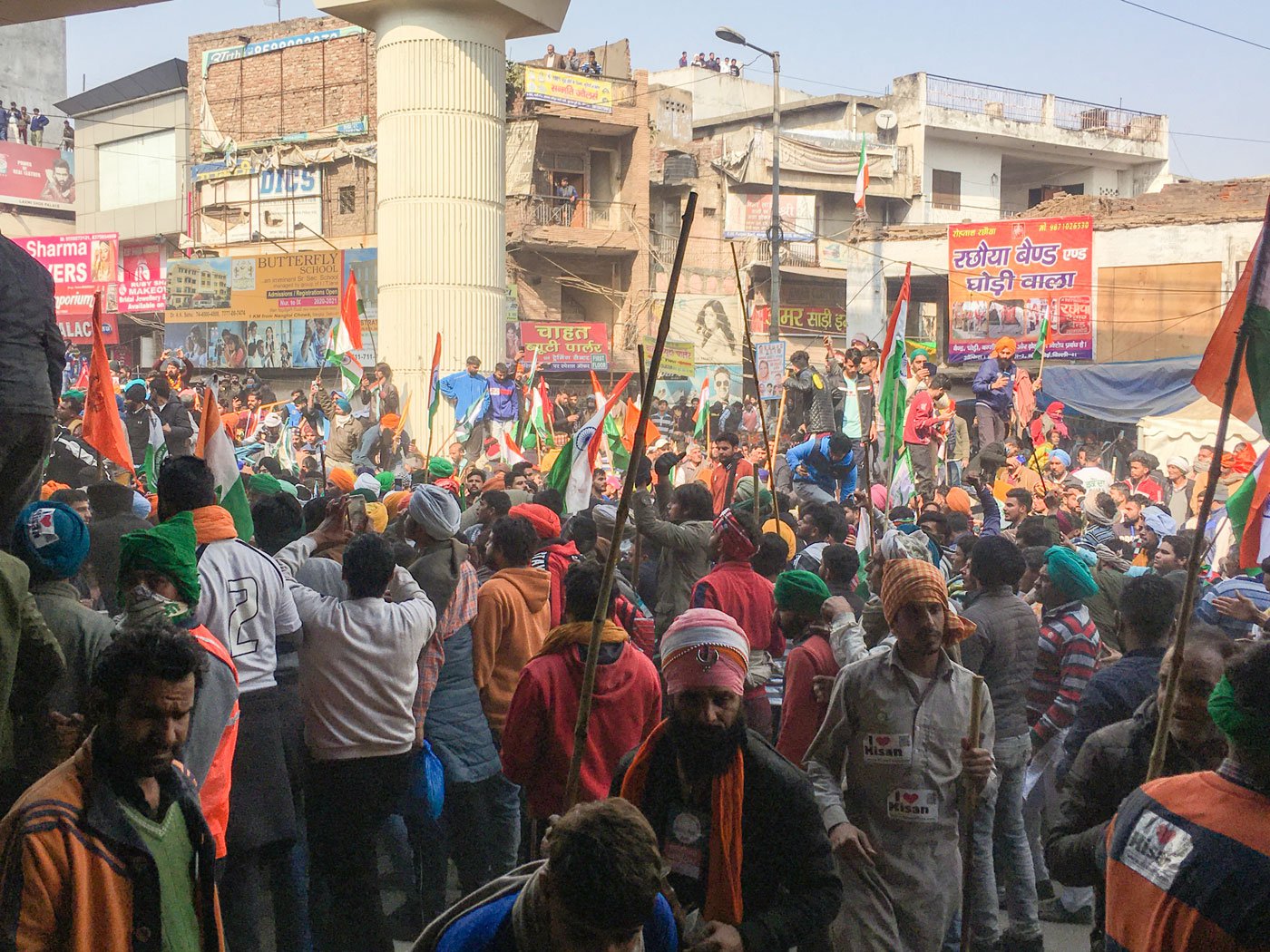
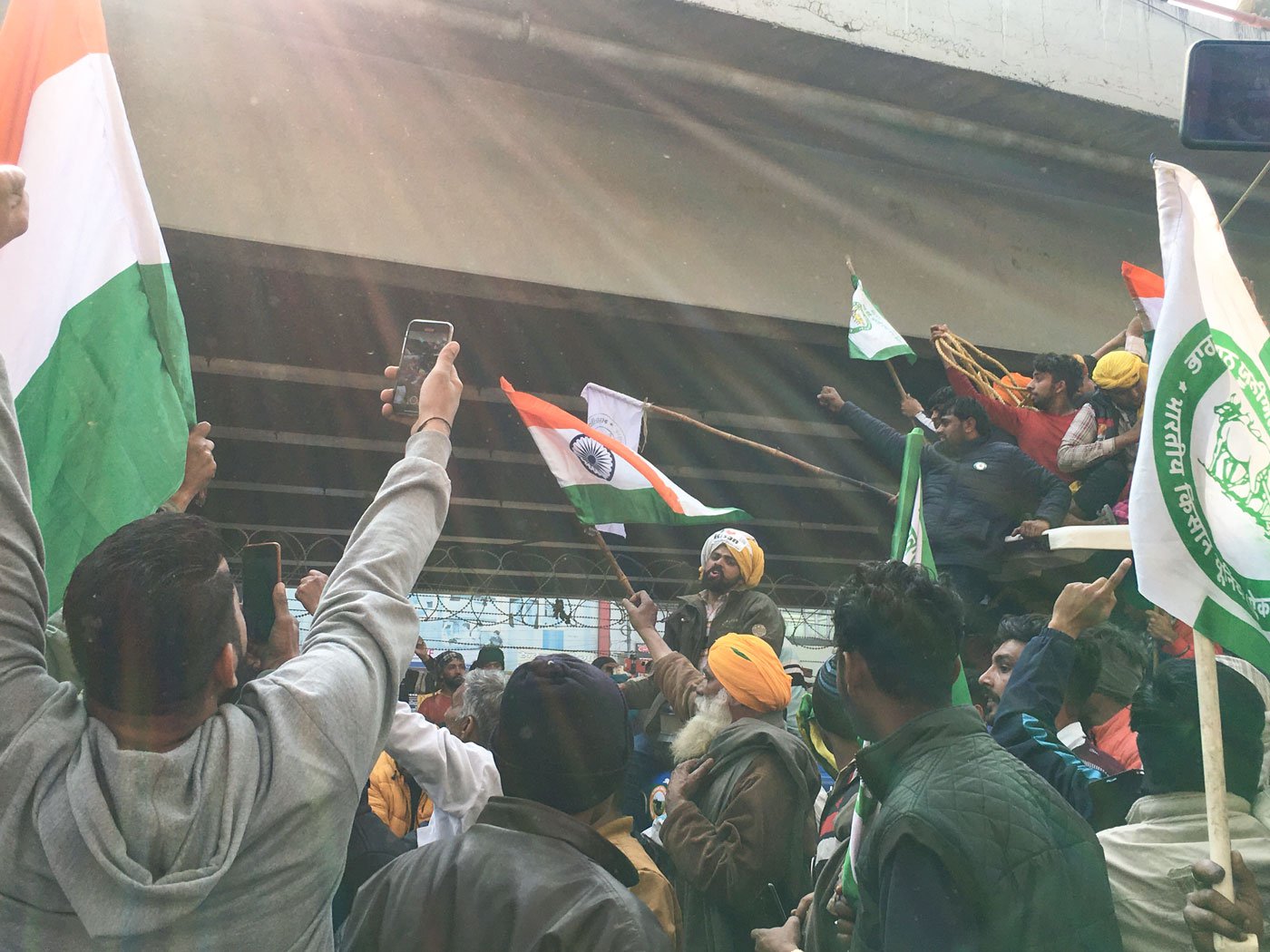
But then, a group in tractors broke the barricades at Nangloi chowk , amidst hooting from the occupants of some of these tractors (Photos: Sanskriti Talwar)
The farm laws that she and the other farmers are protesting against were first passed as ordinances on June 5, 2020, then introduced as farm bills in Parliament on September 14, and hastened into Acts by the 20th of that month. The three laws are the Farmers (Empowerment and Protection) Agreement on Price Assurance and Farm Services Act, 2020 , the Farmers’ Produce Trade and Commerce (Promotion and Facilitation) Act, 2020 and the Essential Commodities (Amendment) Act, 2020 .
The farmers all see these three laws as devastating for their livelihoods by expanding the space for large corporates to have even greater power over farmers and farming. These laws also undermine the main forms of support to the cultivator, including the minimum support price (MSP), the agricultural produce marketing committees (APMCs), state procurement and more. The laws have also been criticised as affecting every Indian as they disable the right to legal recourse of all citizens , undermining Article 32 of the Constitution of India.
Jasvinder Kaur has been at Tikri since November 26, and has gone back to her home in Mehlan village only twice since then. “I have been protesting since August last year. First, we protested in our villages. Then we went to Patiala district for five days to protest,” she said. “When the son of a mother can sit here in protest in this cold, then how can that mother sit inside her house?” she asked, alluding to the Chief Justice’s statement (of January 11) that women, children and elderly must be ‘persuaded’ to go back from the protest sites due to the cold and Covid-19.
Back in Sangrur, her family cultivates mainly wheat and paddy on seven acres of farmland. “We can grow a number of [other] crops too,” she said. “But MSP rates are only fixed for wheat and paddy. So we don’t cultivate other crops.” Once, she recalled, the family grew peas. “We sold those peas for Rs. 2 per kilo. After that we never cultivated any other crops except wheat and paddy. But if the government won’t guarantee MSP even on these, where will we go?”
In the same trolley was 24-year-old Sukhvir Singh, who too had come from Mehlan village where his family owns six acres of farmland. “The government says they have fixed 1,800 rupees for a quintal of maize,” he said. “But I have sold it for Rs. 600 a quintal. Ask anyone in our village who has sold it above this rate. This is our situation. What will happen if the government doesn't give any guarantee on MSP ? That’s why we have come out on roads to demand our rights.”
While I was talking to Jasvinder and Sukhvir – both members of the Bhartiya Kisan Union (Ekta Ugrahan) – someone from another tractor came to tell them that their union leader is asking everyone to return.
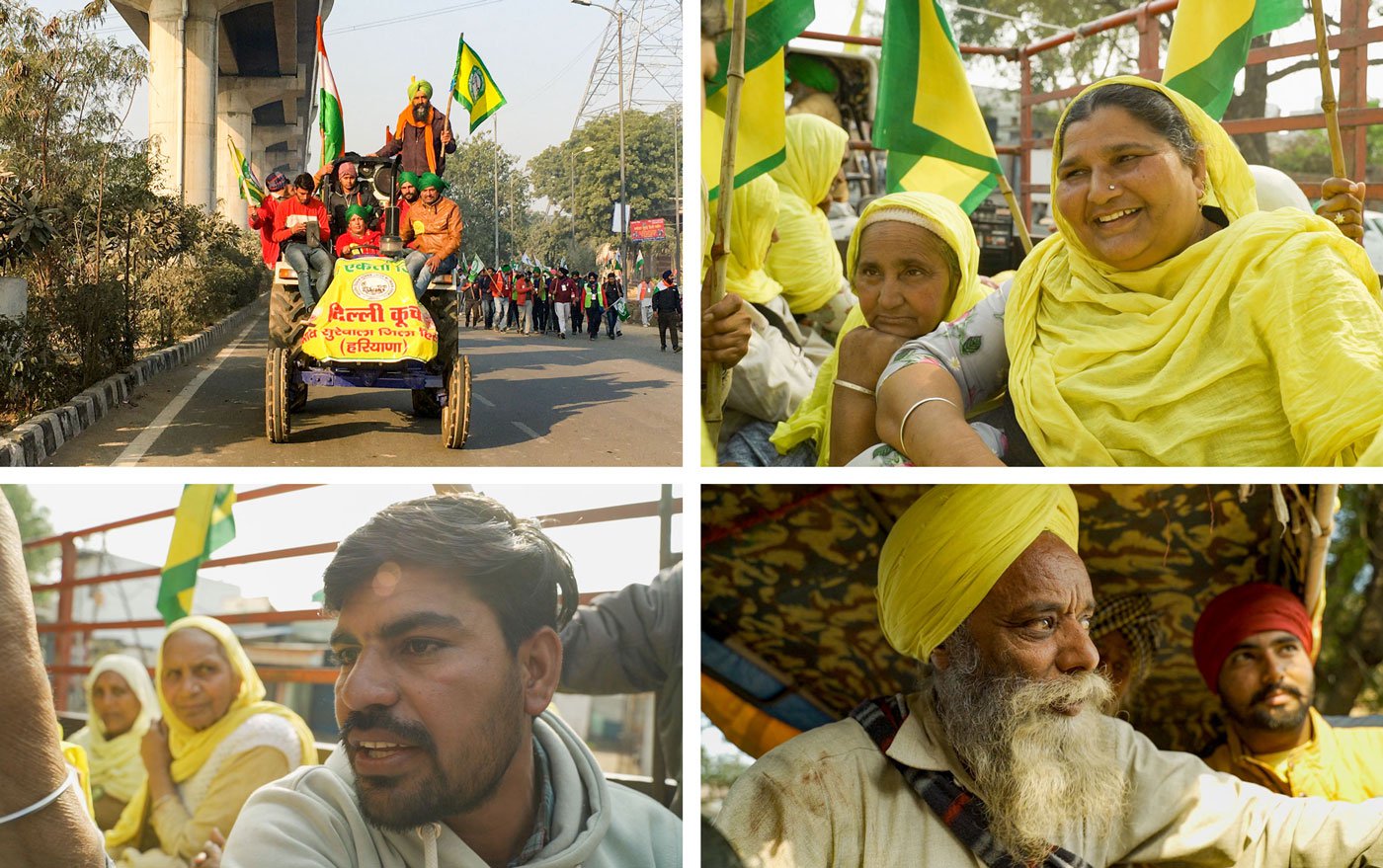
Top left: Poonam Pattar from Haryana’s Hisar district learnt to drive a tractor only to be able to participate in this parade (Photo: Sanskriti Talwar). Top right: Jasvinder Kaur in a trolley on the Nangloi-Najafgarh road said, 'We will carry on our protest peacefully and will do no harm'. Bottom left: Sukhvir Singh from Punjab's Sangrur district said, 'We were asked to return because of some wrongdoers'. Bottom right: Kanan Singh said, 'We had come here to get the three farm laws repealed' (Photos: Naveen Macro)
As I hopped out of their trolley at around 2.30 p.m., they took a U-turn near the Jharoda Kalan township in south-west Delhi to return to their camps – the township is around 11 kilometres from the Nagloi-Najafgarh road. By then, the convoy had covered a total of around 27 kilometres from Tikri.
Around noon, I’d seen at least four of the breakaway tractors going ahead on their chosen route. The police didn’t take any action then. But by around 2 p.m., when news started coming in that other groups of farmers and individuals who broke away at Singhu and Ghazipur had reached ITO and Red Fort, some groups at Tikri also insisted on moving ahead and going to Red Fort. It was then that clashes began between the police and members of these groups. The police retaliated with lathis and teargas shells. This continued till around 4:30 p.m.
The tractors of the Bharatiya Kisan Union (Ekta Ugrahan) that were nearing Nangloi chowk around 4 p.m. from the KMP Expressway arm also decided to return to their camps at Tikri.
Stuck in his tractor in traffic near the Jharoda Kalan township, 65-year-old Kanan Singh from Sherpur block of Sangrur district, said “We have been living on roads for over two months now. We had come here to get the three farm laws repealed. We will leave for Punjab only when that happens.”
By 8 p.m., the Samyukta Kisan Morcha, the united front of the protesting farmers, and other farm leaders, dissociated themselves from the violence and strongly condemned those incidents. “We condemn and regret the undesirable and unacceptable events that have taken place today and dissociate ourselves from those indulging in such acts. Despite all our efforts, some organisations and individuals have violated the route and indulged in condemnable acts. Anti-social elements had infiltrated the otherwise peaceful movement,” they said in a statement.
“We were asked to return because of some wrongdoers,” Sukhvir later told me. “Those were not our people. We didn’t come to Delhi to do anything like this. We have only come to get these black laws repealed.”
“We will leave if tomorrow the government repeals these laws,” said Jasbir Kaur Natt, state committee member of the Punjab Kisan Union. “Why would we stay on then? We have been protesting here for that very reason – for a repeal of these black laws.”
Cover photo: Satyraj Singh
